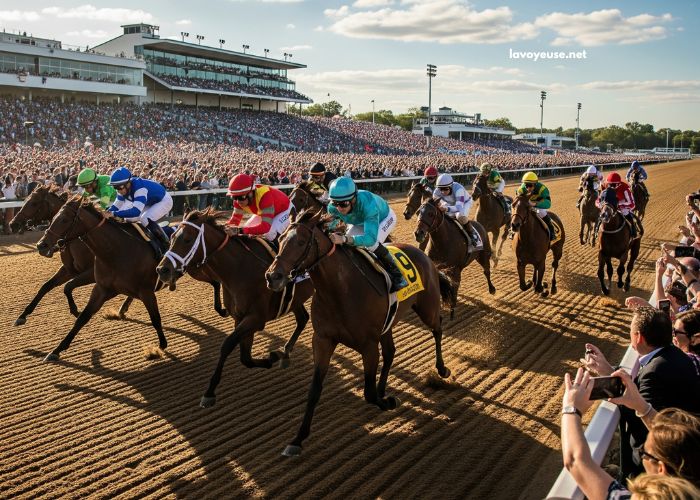In the vibrant realm of horse racing, understanding the intricacies of betting is essential for success. Good Hippique Turf serves as a vital framework for bettors looking to improve their strategies and gain an edge in this thrilling sport.
The approach encapsulated in Good Hippique Turf emphasizes the importance of data analysis, expert insights, and strategic planning. By leveraging these elements, bettors can navigate the complexities of horse racing with confidence and precision.
What is Good Hippique Turf?
Good Hippique Turf refers to a structured approach to horse racing betting that focuses on maximizing success through informed decisions. This framework integrates statistical analysis, historical data, and insights from industry experts to help bettors make educated choices.
At its core, Good Hippique Turf emphasizes a thorough understanding of race dynamics, including horse performance, track conditions, and jockey statistics. By considering these factors, bettors can develop a comprehensive strategy that increases their chances of selecting winning horses.
Additionally, Good Hippique Turf serves as a community-oriented resource, connecting bettors with shared interests and providing them access to tools and information that enhance their betting experience. This supportive environment is crucial for fostering informed decision-making and a deeper appreciation of the sport.
How Does Good Hippique Turf Work?
The operational framework of Good Hippique Turf revolves around data collection and analysis. Bettors begin by gathering comprehensive information about the horses, jockeys, and races. This includes previous race performances, speed ratings, and various metrics that help predict outcomes.
Once the data is collected, bettors apply analytical techniques to interpret the information. This can involve statistical modeling and trend analysis, allowing bettors to identify patterns that may indicate a horse’s likelihood of winning. By employing this methodical approach, participants in Good Hippique Turf can make more informed betting decisions.
Furthermore, Good Hippique Turf encourages continuous learning and adaptation. As new data becomes available and racing conditions change, bettors must refine their strategies accordingly. This adaptability is key to maintaining a competitive edge in the dynamic world of horse racing betting.
What Types of Bets Are Associated with Good Hippique Turf?
Within the Good Hippique Turf framework, several types of bets are available to participants, each offering unique opportunities and challenges. One of the most straightforward options is the win bet, where bettors select a horse to finish first in a race. This type of bet is popular among beginners due to its simplicity.
In addition to win bets, the Good Hippique Turf system includes place and show bets, which allow bettors to wager on horses finishing in the top two or three positions, respectively. These bets offer a safety net for bettors, as they do not require the horse to win outright, increasing the chances of a successful wager.
For those seeking more complex betting options, Good Hippique Turf features exotic bets such as exactas and trifectas. These require bettors to predict the top finishers in specific order, providing the potential for higher payouts but also demanding a more in-depth understanding of the race dynamics.
What Are the Advantages of Using Good Hippique Turf?
Engaging with Good Hippique Turf offers numerous benefits for horse racing enthusiasts. One of the primary advantages is the emphasis on data-driven decision-making. By utilizing historical data and statistical analysis, bettors can make more informed choices, leading to improved outcomes.
Another significant benefit of Good Hippique Turf is its flexibility. With various betting types available, participants can tailor their strategies to align with their risk tolerance and experience level. This adaptability allows bettors to experiment with different approaches and find what works best for them.
Moreover, Good Hippique Turf fosters a sense of community among bettors. Through shared insights and experiences, participants can learn from one another and enhance their understanding of horse racing. This collaborative environment not only enriches the betting experience but also promotes a deeper appreciation for the sport.
How Do You Analyze Races for Good Hippique Turf Betting?
Analyzing races effectively is crucial for success within the Good Hippique Turf framework. Bettors should begin by gathering detailed information on each horse’s past performances. This includes reviewing race results, speed figures, and other relevant statistics that indicate how a horse has performed under various conditions.
In addition to horse data, it is essential to consider factors such as track conditions and race distance. Horses may excel on certain surfaces or distances, so understanding these variables can greatly influence betting decisions. Bettors must also assess the competition, analyzing the strengths and weaknesses of other horses in the race.
Furthermore, staying informed about jockey and trainer performance is vital. A skilled jockey can significantly impact a horse’s performance, while a reputable trainer often indicates a horse’s readiness for a race. By synthesizing all this information, bettors can enhance their strategies and make well-rounded decisions within the Good Hippique Turf framework.
What Factors Influence Betting Decisions in Good Hippique Turf?
Several critical factors influence betting decisions within Good Hippique Turf. One primary consideration is the horse’s form, which reflects its recent performance in races. Bettors should assess how well a horse has performed in its last few outings, as this can provide insight into its current condition and competitiveness.
Another important factor is the track conditions on race day. Different horses perform variably on various surfaces, such as turf or dirt, and under different weather conditions. Understanding how these factors interact with a horse’s strengths can help bettors make more informed decisions.
Additionally, the betting pool itself plays a crucial role in determining odds and potential payouts. The size of the pool can affect the overall returns for winning bets, and bettors should be aware of how collective betting activity shapes the odds. This understanding is essential for strategic decision-making within Good Hippique Turf.
How Can Data Analysis Improve Your Good Hippique Turf Betting Strategy?
Data analysis is a cornerstone of effective betting strategies within Good Hippique Turf. By systematically reviewing historical race data, bettors can identify trends that inform their predictions. This can include analyzing how specific horses have performed in similar races or conditions, allowing for more accurate forecasts.
Utilizing technology and analytical tools can significantly enhance the data analysis process. Many platforms offer robust databases and statistical models that can help bettors visualize data and highlight potential winning horses. By leveraging these resources, bettors can refine their strategies and improve their chances of success.
Moreover, continuous monitoring of new data is crucial. As races occur and fresh information becomes available, bettors must update their analyses to reflect the most current conditions. This proactive approach ensures that predictions remain relevant and accurate, solidifying the effectiveness of the Good Hippique Turf strategy.
What Common Mistakes Should Be Avoided When Using Good Hippique Turf?
While Good Hippique Turf offers a structured approach to betting, there are common pitfalls that bettors should be mindful of. One prevalent mistake is neglecting thorough research. Bettors who rely on incomplete or outdated information may struggle to make informed decisions, leading to poor betting outcomes.
Another common error is overconfidence in predictions. Bettors may become overly reliant on data, forgetting to consider the unpredictable nature of horse racing. Maintaining a balanced perspective is essential, recognizing that while data provides valuable insights, it does not guarantee results.
Additionally, managing expectations is vital. Bettors who experience a series of losses may become discouraged and make impulsive decisions. Understanding that success in horse racing betting requires patience and a long-term perspective is essential for sustainable success within the Good Hippique Turf framework.
Conclusion
Engaging with Good Hippique Turf provides horse racing enthusiasts with a comprehensive framework for enhancing their betting strategies. By emphasizing data analysis, community support, and informed decision-making, this approach equips bettors with the tools needed to navigate the complexities of the sport effectively. As you delve deeper into the world of horse racing, embracing the Good Hippique Turf methodology will empower you to make more educated choices and enjoy the thrilling experience of betting with confidence and skill.

